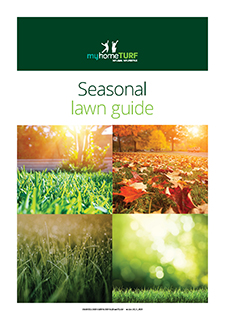How to Control Grey Leaf Spot in your Lawn
Grey Leaf Spot is a fungal disease that can affect both grassy and broadleaf plants. The disease is often a problem during wet and humid spring weather. Lawns infected with ...

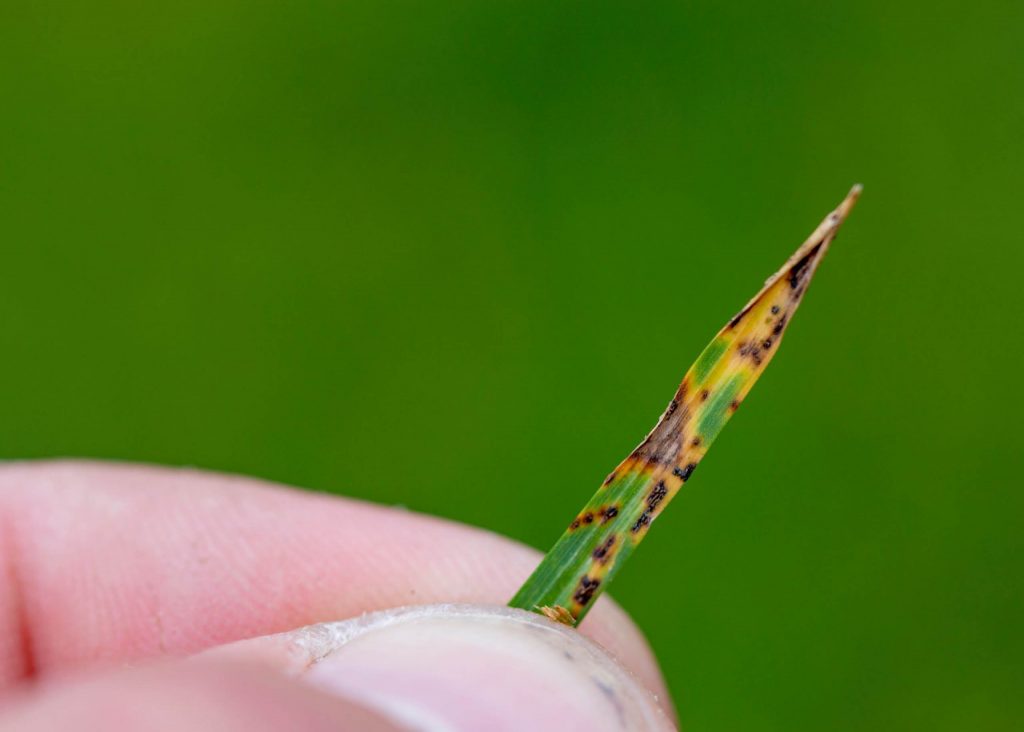 When disease attacks your turf, control can be difficult unless you know how to identify lawn diseases and understand the causes and prevention behind them.
When disease attacks your turf, control can be difficult unless you know how to identify lawn diseases and understand the causes and prevention behind them.
Is it Dollar Spot or Fusarium Patch?
Many common lawn diseases have fungal problems at their source such as Powdery Mildew.
Fortunately, proper lawn maintenance and care can help prevent and resolve most lawn diseases.
Read myhomeTURF’s comprehensive lists of Common Lawn Diseases and learn how to prevent or control them from invading your lawn.
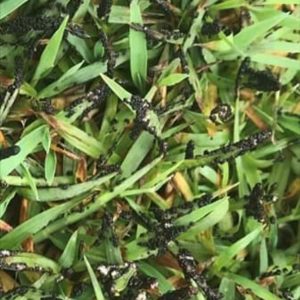 Black Spot is characterised by black spots on the upper side of your lawn’s leaves and occurs due to fungal diseases such as Leaf Spot, Pythium Blight, Leaf Smut and Slime Mould.
Black Spot is characterised by black spots on the upper side of your lawn’s leaves and occurs due to fungal diseases such as Leaf Spot, Pythium Blight, Leaf Smut and Slime Mould.
These black spots not only look unattractive and serve as an eyesore, they sabotage the health and vigour of the lawn and weaken its structure.
During warmer weather, massive deluges combined with the heat and humidity create the ideal conditions for Black Spot.
General symptoms include, leaf blades with reddish-black to purplish-black spots, mould-like masses on the lawn and cobweb-like growths of fungi usually apparent during humid, wet mornings or evenings.
The best approach to control Black Spot in your lawn is through a proper lawn care maintenance routine.
Proper lawn care maintenance ensures a healthy lawn and includes adequate fertiliser, reduction of thatch levels, aeration, morning watering that is deep and infrequent and mowing at regular intervals.
Alternately if the above lawn care maintenance procedures do not work, fungicides with the Common Active Ingredient – Iprodione should be used.
myhomeTURF recommends using Indigo Voltar an effective Broad Spectrum Fungicide that can be purchased through our myhomeTURF online store.
Rust is a fungal disease that occurs on your lawn when its growth is slowed.
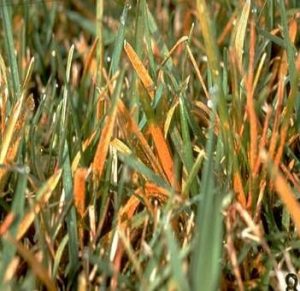 Rust usually appears in late summer or early autumn and during periods of dry weather or when the grass is low on nitrogen.
Rust usually appears in late summer or early autumn and during periods of dry weather or when the grass is low on nitrogen.
Lawn Rust weakens the strength of your lawn and makes it more susceptible to other diseases and turf problems.
The Rust is identified by pulling a couple of blades out of the lawn. The lawn blades will be coated with orange-red to yellowish brown dust or spores.
Lawn rust begins with yellowing leaf blades and small yellowish spots which mature to orange, red or brown colouring.
The Rust’s spores can be rubbed off the grass blades with a finger.
Overall, rust patches of the grass will become thin and weak.
The best approach to control Rust in your lawn is through proper lawn care maintenance.
Proper lawn care maintenance ensures a healthy lawn and includes adequate fertiliser, reduction of thatch levels, aeration, morning watering that is deep and infrequent and mowing at regular intervals.
Alternately if the above lawn care maintenance procedures do not work, fungicides with the Common Active Ingredient – Propiconazole should be used.
myhomeTURF recommends using Bumper an effective fungicide that can be purchased through our myhomeTURF online store.
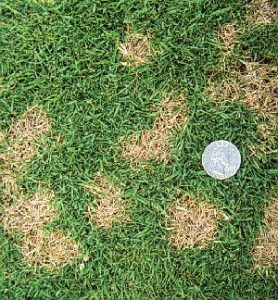 Dollar Spot (AKA SMALL BROWN PATCH) is a fungus with the name referring to a small, sunken, circular patch 1.5 to 5cm in diameter on the surface of your lawn.
Dollar Spot (AKA SMALL BROWN PATCH) is a fungus with the name referring to a small, sunken, circular patch 1.5 to 5cm in diameter on the surface of your lawn.
The Dollar Spot patches turn from brown to a straw colour on your lawn and may eventually merge into larger irregular shaped areas.
Dollar Spot is often due to inadequate nutrients in the soil or poor lawn care, such as watering at night, thatch build-up, soil compaction and poor drainage.
Infected leaves may display small lesions that turn from yellow-green to straw colour with a reddish-brown border.
Dollar Spot is more prevalent on your lawn in autumn and spring during warm day temperatures, high humidity and cool nights that produce heavy dews.
The best approach to control Dollar Spot in your lawn is through proper lawn care maintenance.
Proper lawn care maintenance ensures a healthy lawn and includes adequate fertiliser, reduction of thatch levels, aeration, morning watering that is deep and infrequent and mowing at regular intervals.
Alternately if the above lawn care maintenance procedures do not work, fungicides with the Common Active Ingredient – Propiconazole should be used.
myhomeTURF recommends using Bumper an effective fungicide that can be purchased through our myhomeTURF online store.
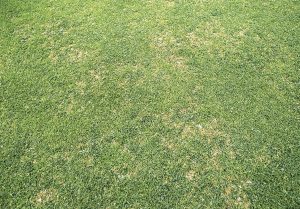 Anthracnose is a foliar disease or a basal rot of the lower leaves of your lawn.
Anthracnose is a foliar disease or a basal rot of the lower leaves of your lawn.
Lawns infected with anthracnose have leaves that turn yellow to a light tan to brown before dying – younger leaves often turn red.
Lawn Anthracnose infected areas are seen as irregular shaped patches, reddish brown in colour which turn yellow then tan to brown.
Anthracnose favours temperatures over 25°C, humid conditions, lawns that have soil compaction and low amounts of nitrogen.
Proper lawn care maintenance which includes adequate fertiliser, reduction of thatch levels, aeration, morning watering that is deep and infrequent and mowing at regular intervals is recommended to prevent Anthracnose.
Alternately if the above lawn care maintenance procedures do not work, common remedies such as Neem oil, Bacillus subtilis, Sulfur Dust Fungicides, Liquid Copper Fungicides or Fungicides with the Common Active Ingredient Penthiopyrad – please first seek advice from your Local Garden Centre.
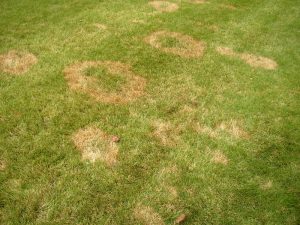 Brown Patch is a lawn summer disease caused by a fungus and is rife during warmer months when the humidity is high.
Brown Patch is a lawn summer disease caused by a fungus and is rife during warmer months when the humidity is high.
Once started, Brown Patch can quickly spread on your lawn with damage first appearing as a circular area ( between 20cm to a metre) of brown and dead grass enclosed by a darker colour.
Typically, Brown Patch infects lawns of poor health.
The best approach to control Brown Patch in your lawn is through proper lawn care maintenance.
Proper lawn care maintenance ensures a healthy lawn and includes adequate fertiliser, reduction of thatch levels, aeration, morning watering that is deep and infrequent and mowing at regular intervals.
Alternately if the above lawn care maintenance procedures do not work, fungicides with the Common Active Ingredient – Prodione should be used.
myhomeTURF recommends using Indigo Voltar an effective Broad Spectrum Fungicide that can be purchased through our myhomeTURF online store.
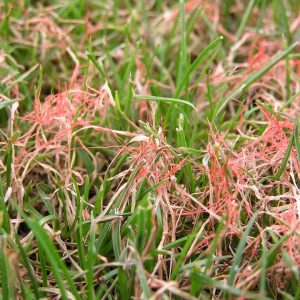 Red Thread is a fungal disease found on lawns and is circular or irregularly shaped with small to large patches (5 to 15cm) in diameter.
Red Thread is a fungal disease found on lawns and is circular or irregularly shaped with small to large patches (5 to 15cm) in diameter.
The first symptom of Red Thread in turf is the tan colour of dead grass leaves.
Dead lawn leaves caused by Red Thread are generally interspersed among uninfected leaves giving an overall diffuse, scorched or ragged appearance to the patch.
Red Thread thrives in temperatures between 17°C to 29°C which are also humid.
Read Thread causes fungus primarily during periods when grass is growing slowly as a result of low temperatures, drought or inadequate fertility.
Proper lawn care maintenance which includes adequate fertiliser, reduction of thatch levels, aeration, morning watering that is deep and infrequent and mowing at regular intervals is recommended to prevent Red Thread.
If the above lawn maintenance practices do not work try using a fungicide with the Common Active Ingredient Penthiopyrad – please first seek advice from your Local Garden Centre.
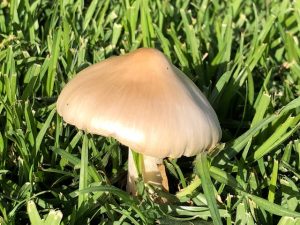 Fairy Rings, or Mushrooms, are a clear sign of beneficial microbes at work in your lawn, which is all part of your lawn’s ecosystem.
Fairy Rings, or Mushrooms, are a clear sign of beneficial microbes at work in your lawn, which is all part of your lawn’s ecosystem.
In fact, mushrooms and toadstools are the reproductive part of a type of fungi that lives in the soil.
For much of the time, these fungal structures remain hidden underground, breaking down organic material in your lawn – a very good thing!
When the conditions are right (moist, damp, shady and/or humid), mushrooms shoot through from the underground structures and appear in your lawn.
Proper lawn care maintenance which includes adequate fertiliser, reduction of thatch levels, aeration, morning watering that is deep and infrequent and mowing at regular intervals is recommended to prevent Fairy Rings.
If lawn maintenance practices do not work contact your Local Garden Centre however no chemical control options are currently registered.
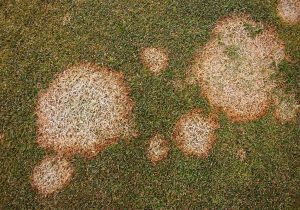 Fusarium Patch is a type of fungus on your lawn that appears in a small circular, water-soaked patch less than 5cm in diameter.
Fusarium Patch is a type of fungus on your lawn that appears in a small circular, water-soaked patch less than 5cm in diameter.
Fusarium Patch change in colour from orange-brown to dark brown and finally to a light gray.
The Fusarium Patches may enlarge indefinitely but are usually less than 20cm in diameter.
On a low-cut lawn, a halo-like “smoke ring” may appear on the outer margin of the Fusarium Patch and the outer ring may also have a water-soaked appearance.
Conditions favouring Fusarium Patch include consecutive wet days of cool temperatures which could occur in either autumn or spring.
If a lawn’s soil is high in nitrogen but low in phosphorous and potassium, then conditions are rife for the growth of Fusarium Patch.
Lawn areas with slow growing conditions and heavy thatch development also favour Fusarium Patch.
Proper lawn care maintenance which includes adequate fertiliser, reduction of thatch levels, aeration, morning watering that is deep and infrequent and mowing at regular intervals is recommended to prevent Fusarium Patch.
Alternately if the above lawn care maintenance procedures do not work, Fungicides with the Common Active Ingredient – Iprodione should be used.
myhomeTURF recommends using Indigo Voltar an effective Broad Spectrum Fungicide that can be purchased through our myhomeTURF online store.
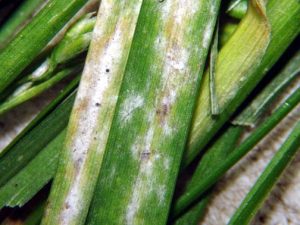 Powdery Mildew on lawn is caused by a fungus and usually first seen as isolated fine, grey-white, cobwebby growth seen on the upper surface of the leaf blades.
Powdery Mildew on lawn is caused by a fungus and usually first seen as isolated fine, grey-white, cobwebby growth seen on the upper surface of the leaf blades.
Powdery Mildew growth rapidly becomes denser and often involves the entire leaf surface of your lawn giving the appearance of having been dusted with talc powder or flour.
When Powdery Mildew becomes severe, the entire lawn appears a dull white or pale green and severely infected leaves usually turn yellow and wither and may lead to a widespread thinning of the stand.
Powdery Mildew occurs most often on slow-growing turf, usually in shaded areas and it favours cool, cloudy conditions that occur in spring and autumn.
Proper lawn care maintenance which includes adequate fertiliser, reduction of thatch levels, aeration, morning watering that is deep and infrequent and mowing at regular intervals is recommended.
Alternately if the above lawn maintenance practices do not work a fungicide that contains the Common Active Ingredient, Myclobutanil will inhibit the mildew’s development – please first seek advice from your Local Garden Centre.
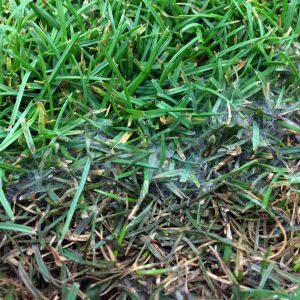 The first sightings of Pythium disease on your lawn are small patches of grass that looks water-soaked and a dark purplish colour.
The first sightings of Pythium disease on your lawn are small patches of grass that looks water-soaked and a dark purplish colour.
When touching the grass blades of Pythium disease affected lawns you will notice a greasy or slimy feel.
The infected Pythium disease lawn blades will eventually shrivel and die.
Pythium disease usually concentrates in low, wet areas or along the natural course of your lawn’s drainage.
Conditions favouring Pythium disease are hot days (30°C – 35°C), humid or rainy weather when night temperatures are warm (above 20°C).
Proper lawn care maintenance which includes adequate fertiliser, reduction of thatch levels, aeration, morning watering that is deep and infrequent and mowing at regular intervals is recommended to prevent Pythium Disease.
Alternately if the above lawn care maintenance procedures do not work, fungicides with the Common Active Ingredient – Metalaxyl-M can be used – please first seek advice from your Local Garden Centre.
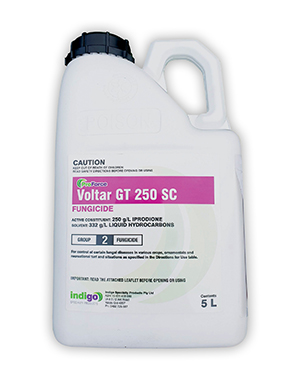
Indigo Voltar Fungicide 5L is a broad-spectrum Fungicide with the active ingredients of Iprodione (250g/L) and Liquid hydrocarbons (332g/L). Suitable for Zoysia, Kikuyu, Couch and Buffalo grasses. Always read the safety directions and instructions on the product label before use.
SHOP NOW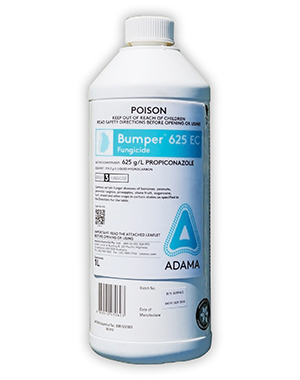
Bumper 1L liquid is a superior Fungicide for use on Couch grasses with an active ingredient of Propiconazole (625g/L). Always read the safety directions and instructions on the product label before use.
SHOP NOW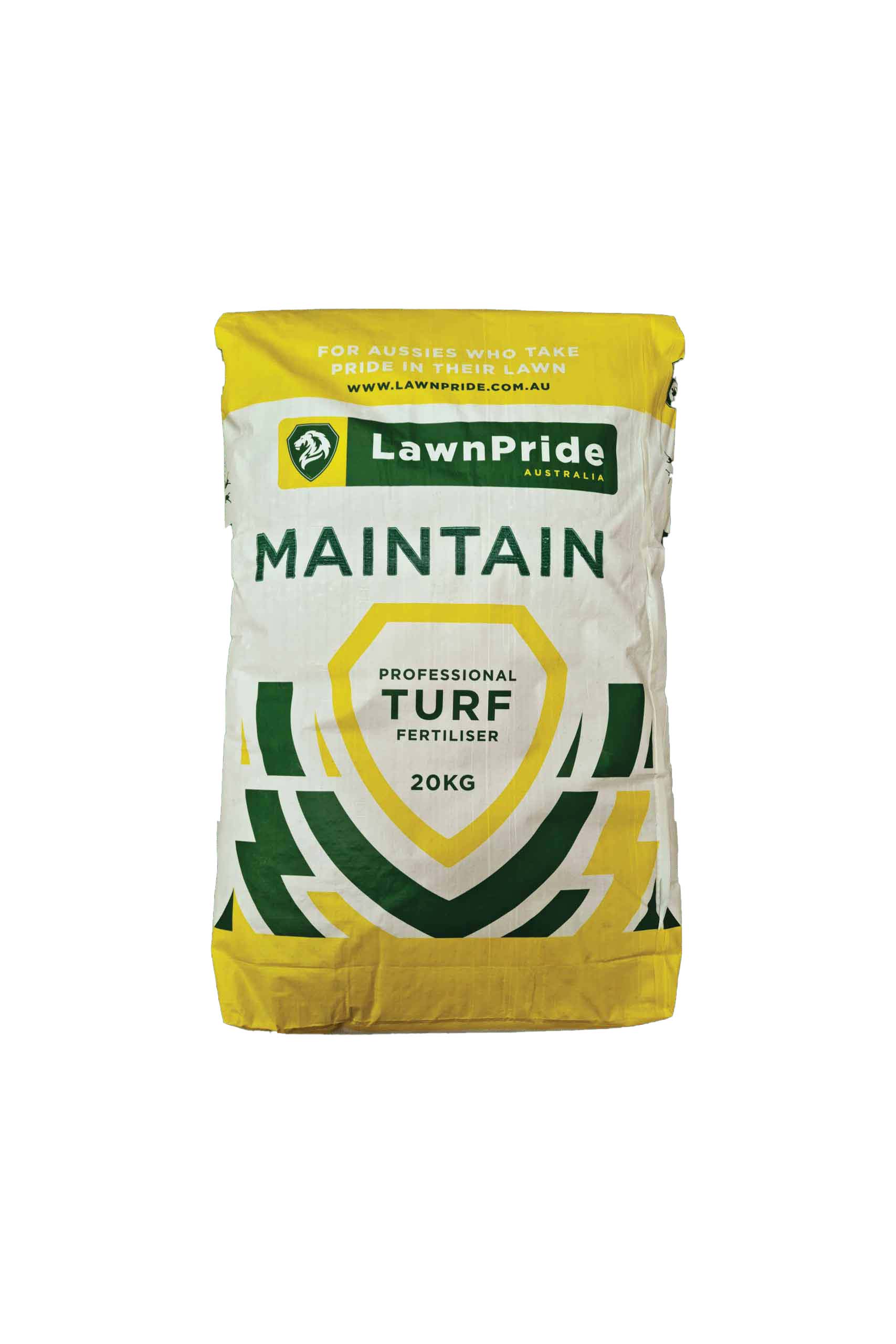
Lawn Pride Maintain 26-2-9 + 3.4 Fe 20kg is one of the most popular granular all-round lawn fertilisers on the market with the active ingredients of Nitrogen (N – 26), Phosphorus (P – 2), Potassium(K – 9) and Iron (Fe – 3.4). Suitable for Zoysia, Kikuyu, Couch and Buffalo grasses. Always read the safety directions and instructions on the product label before use.
SHOP NOWSign up for our Newsletter to receive your free guide.
